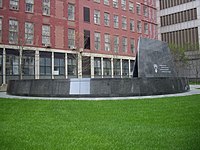
Photo from wikipedia
OBJECTIVES The issues addressed in this article are those related to the bioethical actions and decisions surrounding the excavation of the New York African Burial Ground (NYABG) in the 1990s,… Click to show full abstract
OBJECTIVES The issues addressed in this article are those related to the bioethical actions and decisions surrounding the excavation of the New York African Burial Ground (NYABG) in the 1990s, the significance of conducting research on historical African/African American remains, and the eminence of protecting newly discovered African American burial sites in the future for research purposes. MATERIALS AND METHODS Skeletal (n = 419, at the time of excavation) and soil (n = 92) remains of the 17th and 18th century New York African Burial Ground were used to discuss the necessity of research on historical African/African American remains. DISCUSSION Studying the remains of enslaved Africans is critical to understanding the biological processes and existence of all people. Researching the NYABG site, the oldest and largest burial site of free and enslaved Africans, illuminates the necessity and significance of scientific research on other historical African/African American cemeteries throughout the nation. The results of future research will provide a more profound sense of identity for a group of people who were forcefully severed from their genetic and cultural origins. This research will increase the representation of African descended people in genomic, anthropological, and cultural research, and ultimately help researchers to learn more about the origins of all humans.
Journal Title: American journal of physical anthropology
Year Published: 2020
Link to full text (if available)
Share on Social Media: Sign Up to like & get
recommendations!